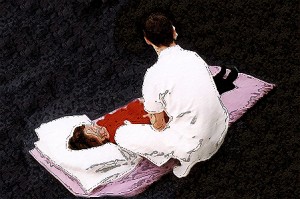
What is Shiatsu?
Shiatsu (pronounced shee-at-soo) is not merely another massage system. It is a complete therapy system developed in Japan that combines Traditional Chinese Medicine (acupuncture/acupressure) and manipulation Traditional Japanese Massage(Amna).
Shiatsu is a Japanese word meaning “finger pressure” and is the name coined early in the 20th century to describe this form of healing. It has been recognised as a healing system by the Japanese Government for over 50 years and has recently been recognised by the European Parliament and included as one of only six named therapies in the European Register of Non-Conventional Medical Disciplines – the others being Acupuncture, Homoeopathy, Herbalism, Osteopathy & Chiropractic. This year, the BMA started to petition the Government to include Acupuncture within the NHS. They also stated that they are looking at other therapies that they wish to be included – these are all included within the European Register and the CAM (Complementary and Alternative Medicine) report, dealing with this, is currently going through the House of Lords.
Therapist training
To become a professional Shiatsu Therapist – becoming a Member of the Register of the Shiatsu Society – entails a three-year course in which you study Traditional Chinese Medicine, Shiatsu, Anatomy, Physiology, and Pathology. It is only after graduating from a ratified school that you are allowed to sit the Shiatsu Society examination, with a period of at least six months between these exams. And only after passing this exacting examination can you use the letters MRSS.
Findings from the European Shiatsu Federation research study carried out by Professor Andrew Long at the University of Leeds.
The Experience and Effects of Shiatsu: A Cross-European Study.
- 89% of Shiatsu receivers felt calmer and more relaxed.
- Up to 60% of regular shiatsu receivers slept better.
- Receivers rated their symptoms as significantly reduced throughout the 6 month study.
- 86% said that shiatsu was effective in treating stress and tension, structural and postural problems, low energy and fatigue.
- Overall, Shiatsu receivers adopted a more relaxed, healthier and balanced approach to life.
- Reduced use of conventional medicine.
VIENNA HOSPITALS SHIATSU STUDY:
This amazing film that is based on over 30,000 Shiatsu treatments that were carried out in a number of Vienna hospitals over a 15 year period. In it, the doctors tell tell us how big a success it was and why Shiatsu should be used in conjunction with mainstream, alopathic, medicine. You really must watch this if you have any doubts as to the efficacy of Shiatsu.
Watch the video here.
An overview of the Shiatsu ethos
In Western medicine you can use the analogy of the doctor as a repairman….Wait until the body/mind system is faulty, then repair it. In the Orient however, the analogy could be that of a gardener who constantly tends his plot, thereby ensuring healthy growth. Shiatsu covers both of these aspects – healing and promoting health. Shiatsu is based on Chinese acupuncture and the Japanese system of Anma (massage) and is occasionally referred to in the rather inexact term Acupressure. The practitioner may use fingers, thumbs, elbows and knees to apply pressure as well as incorporating gentle stretches and manipulations. On a subtle level it allows the receiver to relax deeply and get in touch with their body’s own healing abilities. Treatment usually leaves a feeling of well-being and calmness.
Guidelines for patients: –
- It is best not to drink alcohol on the day of the treatment
- Have a light meal at least one hour before your treatment
- Do not take a long hot bath on the day of the treatment
- For treatment wear loose clothing, preferably cotton, such as a tracksuit or a jogging suit
- You will usually remain fully clothed during Shiatsu treatment, which takes place on a padded surface at floor level.
Response to treatment After Shiatsu you will probably feel invigorated yet relaxed. The duration and the frequency of treatment will vary from person to person, as will the total number of treatments. Most people have two opposing tendencies: one, the wish to regain health and freedom: the other, to remain attached to old behaviour patterns which reinforce the sickness. While patients generally experience increased well-being, there may be temporary reactions; these may take the form of a headache or ‘flu like symptoms for 24 hours, in such cases contact your therapist so that they can reassure you. The practitioner may give advice on diet, exercise and lifestyle, encouraging self-understanding and greater independence on health matters. This in turn leads to improved self-confidence and lasting peace of mind for the patient.
See: –

